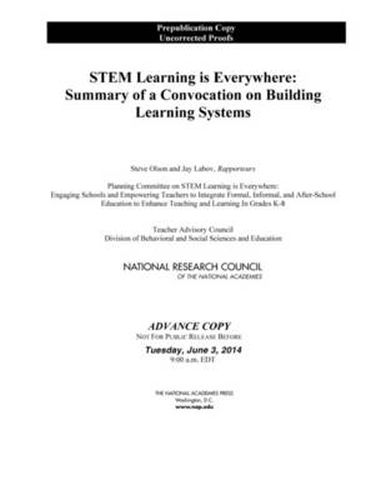Readings Newsletter
Become a Readings Member to make your shopping experience even easier.
Sign in or sign up for free!
You’re not far away from qualifying for FREE standard shipping within Australia
You’ve qualified for FREE standard shipping within Australia
The cart is loading…






Science, technology, engineering, and mathematics (STEM) permeate the modern world. The jobs people do, the foods they eat, the vehicles in which they travel, the information they receive, the medicines they take, and many other facets of modern life are constantly changing as STEM knowledge steadily accumulates. Yet STEM education in the United States, despite the importance of these subjects, is consistently falling short. Many students are not graduating from high school with the knowledge and capacities they will need to pursue STEM careers or understand STEM-related issues in the workforce or in their roles as citizens. For decades, efforts to improve STEM education have focused largely on the formal education system. Learning standards for STEM subjects have been developed, teachers have participated in STEM-related professional development, and assessments of various kinds have sought to measure STEM learning. But students do not learn about STEM subjects just in school. Much STEM learning occurs out of school-in organized activities such as afterschool and summer programs, in institutions such as museums and zoos, from the things students watch or read on television and online, and during interactions with peers, parents, mentors, and role models.
To explore how connections among the formal education system, afterschool programs, and the informal education sector could improve STEM learning, a committee of experts from these communities and under the auspices of the Teacher Advisory Council of the National Research Council, in association with the California Teacher Advisory Council organized a convocation that was held in February 2014. Entitled STEM Learning Is Everywhere: Engaging Schools and Empowering Teachers to Integrate Formal, Informal, and Afterschool Education to Enhance Teaching and Learning in Grades K-8, the convocation brought together more than 100 representatives of all three sectors, along with researchers, policy makers, advocates, and others, to explore a topic that could have far-reaching implications for how students learn about STEM subjects and how educational activities are organized and interact. This report is the summary of that meeting. STEM Learning is Everywhere explores how engaging representatives from the formal, afterschool, and informal education sectors in California and from across the United States could foster more seamless learning of STEM subjects for students in the elementary and middle grades. The report also discusses opportunities for STEM that may result from the new expectations of the Next Generation Science Standards and the Common Core Standards for Mathematics and Language Arts.
$9.00 standard shipping within Australia
FREE standard shipping within Australia for orders over $100.00
Express & International shipping calculated at checkout
Science, technology, engineering, and mathematics (STEM) permeate the modern world. The jobs people do, the foods they eat, the vehicles in which they travel, the information they receive, the medicines they take, and many other facets of modern life are constantly changing as STEM knowledge steadily accumulates. Yet STEM education in the United States, despite the importance of these subjects, is consistently falling short. Many students are not graduating from high school with the knowledge and capacities they will need to pursue STEM careers or understand STEM-related issues in the workforce or in their roles as citizens. For decades, efforts to improve STEM education have focused largely on the formal education system. Learning standards for STEM subjects have been developed, teachers have participated in STEM-related professional development, and assessments of various kinds have sought to measure STEM learning. But students do not learn about STEM subjects just in school. Much STEM learning occurs out of school-in organized activities such as afterschool and summer programs, in institutions such as museums and zoos, from the things students watch or read on television and online, and during interactions with peers, parents, mentors, and role models.
To explore how connections among the formal education system, afterschool programs, and the informal education sector could improve STEM learning, a committee of experts from these communities and under the auspices of the Teacher Advisory Council of the National Research Council, in association with the California Teacher Advisory Council organized a convocation that was held in February 2014. Entitled STEM Learning Is Everywhere: Engaging Schools and Empowering Teachers to Integrate Formal, Informal, and Afterschool Education to Enhance Teaching and Learning in Grades K-8, the convocation brought together more than 100 representatives of all three sectors, along with researchers, policy makers, advocates, and others, to explore a topic that could have far-reaching implications for how students learn about STEM subjects and how educational activities are organized and interact. This report is the summary of that meeting. STEM Learning is Everywhere explores how engaging representatives from the formal, afterschool, and informal education sectors in California and from across the United States could foster more seamless learning of STEM subjects for students in the elementary and middle grades. The report also discusses opportunities for STEM that may result from the new expectations of the Next Generation Science Standards and the Common Core Standards for Mathematics and Language Arts.